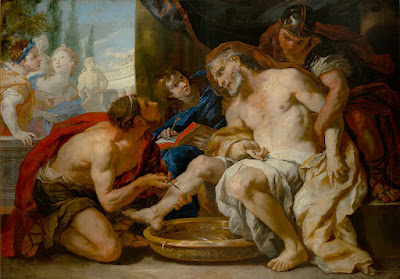-1895-drawing-Kupferstichkabinett-Staatliche-Museen-zu-Berlin.jpg) |
| Arnold Böcklin Paolo and Francesca in Hell (scene from Dante's Inferno) 1895 drawing Kupferstichkabinett, Staatliche Museen zu Berlin |
 |
| Luca Cambiaso Death of Meleager ca. 1570 drawing Museum of Fine Arts, Budapest |
 |
| William Crosbie Post-Mortem ca. 1950 oil on canvas Scottish National Gallery of Modern Art, Edinburgh |
-Chactas-with-the-corpse-of-Atala-(novel-by-Fran%C3%A7ois-Ren%C3%A9-de-Chateaubriand)-1836-oil-on-paper-Mus%C3%A9e-des-Beaux-Arts-de-Lyon.jpg) |
| Francisque Duret (François-Joseph Duret) Chactas with the corpse of Atala (from the novel by François-René de Chateaubriand) 1836 oil on paper Musée des Beaux-Arts de Lyon |
 |
| Frans Floris The Last Judgment 1565 oil on canvas Kunsthistorisches Museum, Vienna |
 |
| Jörgen Fogelquist Hats in the Studio and Reminder of the Events at Soledad Prison, Calif. USA 1971-72 oil on canvas Moderna Museet, Stockholm |
 |
| Théodore Géricault Model posed as Corpse before 1824 drawing Musée Bonnat-Helleu, Bayonne |
-1978-acrylic-on-linen-Moderna-Museet-Stockholm.jpeg) |
| Leon Golub Mao Tse Tung II (in sarcophagus) 1978 acrylic on linen Moderna Museet, Stockholm |
-c1812-drawing-(study-for-painting)-Mus%C3%A9e-Bonnat-Helleu-Bayonne.jpg) |
| Jean-Auguste-Dominique Ingres Fallen Figure for Romulus victorious over Acron ca. 1812 drawing (study for painting) Musée Bonnat-Helleu, Bayonne |
 |
| Sveinung Iversen Fly 2001 etching Sogn og Fjordane Kunstmuseum, Norway |
 |
| Karen Knorr Principles of Political Economy 1991 C-print Moderna Museet, Stockholm |
 |
| Guido Reni Model posed as Dead Christ ca. 1616 drawing Museum Boijmans Van Beuningen, Rotterdam |
-Titian-lying-in-State-in-Palazzo-Barbarigo-1862-oil-on-canvas-Royal-Museum-of-Fine-Arts-Antwerp.jpg) |
| Joseph-Nicolas Robert-Fleury Titian lying in State in Palazzo Barbarigo 1862 oil on canvas Royal Museum of Fine Arts, Antwerp |
 |
| Joseph Roques Death of Marat 1793 oil on canvas Musée des Augustins de Toulouse |
 |
| Johann Michael Rottmayr Death of Seneca ca. 1692 oil on canvas Národní Galerie, Prague |
-Dresden.jpg) |
| Werner Tübke Requiem 1965 oil on canvas, mounted on panel Galerie Neue Meister (Albertinum), Dresden |
"But when rosy-fingered Dawn, the child of morning, appeared (as Homer would say), when from the temple of Artemis rode forth my wise and beautiful Charikleia, then we realized that even Theagenes could be eclipsed, but eclipsed only in such measure as perfect female beauty is lovelier than the fairest of men. She rode in a carriage drawn by a pair of white bullocks, and she was appareled in a long purple gown embroidered with golden rays. Around her breast she wore a band of gold: the man who had crafted it had locked all his art into it – never before had he produced such a masterpiece, and never would he be able to repeat the achievement. It was in the shape of two serpents whose tails he had intertwined at the back of the garment; then he had brought their necks round under her breasts and woven them into an intricate knot, finally allowing their heads to slither free of the knot and draping them down either side of her body as if they formed no part of the clasp. You would have said not that the serpents seemed to be moving but that they were actually in motion. There was no cruelty or fellness in their eyes to cause one fright, but they were steeped in a sensuous languor as if lulled by the sweet joys that dwelt in Charikleia's bosom. They were made of gold but were dark in color, for their maker's craft had blackened the gold so the mixture of yellow and black should express the roughness and shifting hues of their scales. Such was the band round the maiden's breast. Her hair was neither tightly plaited nor yet altogether loose: where it hung long down her neck, it cascaded over her back and shoulders, but on her crown and temples, where it grew in rosebud curls golden as the sun, it was wreathed with soft shoots of bay that held it in place and prevented any unseemly blowing in the breeze. In her left hand she carried a bow of gold, the quiver was slung over her right shoulder, and in her right hand she held a lighted torch. But as she was that day the light in her eyes shone brighter than any torch."
– Heliodorus, from The Aethiopica, or, Theagenes and Charikleia (3rd or 4th century AD), translated from Greek by J.R. Morgan (1989)